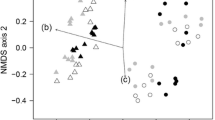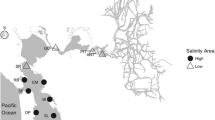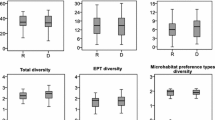Abstract
We assembled information on 119 species of freshwater macroinvertebrate invaders in North America and Europe, and compared them to all native freshwater species in North America and Europe. We tested whether the invaders were a random or selected group among taxa (phylum or class), water quality requirements, and feeding habit. We found that freshwater macroinvertebrate invaders are not a random selection of species, and are over-represented by molluscs and crustaceans, while taxa richness of native communities are dominated by insects. Over 35% of native species of aquatic invertebrates in North America are only able to live in areas with excellent or very good water quality, and are intolerant of organic pollution. In contrast, all invaders are tolerant of at least moderate amounts of organic pollution. There was a significant difference in the distribution of feeding habits between native species and invaders: collector-filterers (including suspension feeders) were 2.5–3 times more abundant, and predators were 3–4 times less abundant among invaders than among native invertebrates. The ongoing spread of exotic species affects the biodiversity of selected taxa, shifts communities toward greater tolerance of organic pollution and increases the numbers of suspension feeders, thereby enhancing benthic pelagic coupling in waterbodies with high densities of invaders. Because these processes are very similar in Europe and North America, we suggest that the observed patterns may have a common global effect.

Similar content being viewed by others
References
Bailey SA, Duggan IC, Jenkins PT et al (2005) Invertebrate resting stages in residual ballast sediment of transoceanic ships. Can J Fish Aquat Sci 62:1090–1103
Baker HG (1965) Characteristics and modes of origin of weeds. In: Baker HG, Stebbins GL (eds) The genetics of colonizing species. Academic Press, London, pp 147–172
Boltovskoy D, Correa N, Cataldo D et al (2006) Dispersion and ecological impact of the invasive freshwater bivalve Limnoperna fortunei in the Río de la Plata watershed and beyond. Biol Invasions 8:974–983
Brockerhoff EG, Liebhold AM, Jactel H (2006) The ecology of forest insect invasions and advances in their management. Can J For Res 36:263–268
Carlton JT (1985) Transoceanic and interoceanic dispersal of costal marine organisms: the biology of ballast water. Oceanogr Mar Biol Ann Rev 23:313–371
Casal CMV (2006) Global documentation of fish introductions: the growing crisis and recommendations for action. Biol Invasions 8:3–11
Causton CE, Peck SB, Sinclair BJ et al (2006) Alien insects: threats and implications for conservation of Galápagos Islands. Ann Entomol Soc Am 99:121–143
Chase JM (2003) Community assembly: when does history matter? Oecologia 136:489–498
Çinar ME, Ergen Z, Dagli E et al (2005) Alien species of spionid polychaetes (Streblospio gynobranchiata and Polydora cornuta) in Izmir Bay, eastern Mediterranean. J Marine Biol Assoc UK 85:821–827
Connell JH, Slatyer RO (1977) Mechanisms of succession in natural communities and their role in community stability and organization. Am Nat 111:1119–1144
Den Hartog C, van den Brink FWB, van der Velde G (1992) Why was the invasion of the River Rhine by Corophium curvispinum and Corbicula species so successful? J Nat Hist 26:1121–1129
Duggan IC, Bailey SA, van Overdijk CDA et al (2006) Invasion risk of active and diapausing invertebrates from residual ballast in ships entering Chesapeake Bay. Mar Ecol Prog Ser 324:57–66
Elton CS (1958) The ecology of invasions by animals and plants. Wiley, New York
Fargione J, Brown CS, Tilman D (2003) Community assembly and invasion: an experimental test of neutral versus niche processes. Proc Natl Acad Sci USA 100:8916–8920
Freeman GH, Halton JH (1951) Note on an exact treatment of contingency, goodness of fit and other problems of significance. Biometrika 38:141–149
Grabowski M, Bacela K, Konopacka A (2007) How to be an invasive gammarid (Amphipoda: Gammaroidea)—comparison of life history traits. Hydrobiologia 590:75–84
Hershey AE, Lamberti GA (2001) Aquatic insect ecology. In: Thorp JH, Covich AP (eds) Ecology and classification of North American freshwater invertebrates, 2nd edn. Academic Press, London, pp 733–775
Hilsenhoff WL (1987) An improved biotic index of organic stream pollution. Great Lakes Entomol 20:31–39
Illies J (1978) Limnofauna Europea. Fischer Verlag, Stuttgart
Karatayev AY, Padilla DK, Minchin D et al (2007) Changes in global economies and trade: the potential spread of exotic freshwater bivalves. Biol Invasions 9:161–180
Keller RP, Lodge DM, Finnoff DC (2007a) Risk assessment for invasive species produces net bioeconomic benefits. Proc Natl Acad Sci USA 104:203–207
Keller RP, Drake JM, Lodge DM (2007b) Fecundity as a basis for risk assessment of nonindigenous freshwater molluscs. Conserv Biol 21:191–200
Kolar CS, Lodge DM (2001) Progress in invasion biology: predicting invaders. Trends Ecol Evol 16:199–204
Lee T, Siripattrawan S, Ituarte CF et al (2005) Invasion of the clonal clams: Corbicula in the new world. Am Malacol Bull 20:113–122
Levine JM, D’Antonio CM (1999) Elton revisited: review of evidence linking diversity and invasibility. Oikos 87:15–26
Lodge DM (1993) Biological invasions—lessons for ecology. Trends Ecol Evol 8:133–137
Loreau M, Mouquet N (1999) Immigration and the maintenance of local species diversity. Am Nat 154:424–440
Lozon JD, MacIsaac HJ (1997) Biological invasions: are they dependent on disturbance? Environ Rev 5:131–144
MacArthur RH, Wilson EO (1967) The theory of island biogeography. In: MacArthur RH (ed) Monographs in population biology, vol 1. Princeton Univ. Press, Princeton
Mack RN (1996) Predicting the identity and fate of plant invaders: emergent and emerging approaches. Biol Conserv 78:107–121
Mack RN, Simberloff D, Lonsdale WM et al (2000) Biotic invasions: causes, epidemiology, global consequences, and control. Ecol Appl 10:689–710
Mandaville SM (2002) Benthic macroinvertebrates in freshwaters—taxa tolerance values, metrics, and protocols. Project H-1, Soil & Water Conservation Society of Metro Halifax. xviii, 48 p, Appendices A–B, 120 p
Merritt RW, Cummins KW (1996) An introduction to the aquatic insects of North America, 3rd edn. Kendall/Hunt Publishing Co, Dubuque
Morton B (1997) The aquatic nuisance species problem: a global perspective and review. In: D’Itri FM (ed) Zebra mussels and aquatic nuisance species. Ann Arbor Press Inc., Chelsea, pp 1–54
Moyle PB, Light T (1996) Biological invasions of fresh water: empirical rules and assembly theory. Biol Conserv 78:149–161
Olenin S, Daunys D (2005) Invaders in suspension-feeder systems: variations along the regional environmental gradient and similarities between large basins. In: Dame R, Olenin S (eds) The comparative roles of suspension-feeders in ecosystems. NATO science series. Earth and environmental series, vol 47. Springer, Dordrecht, The Netherlands, pp 221–237
Pellizzari G, Dalla Monta L (1997) 1945–1995: fifty years of incidental insect pest introduction to Italy. Acta Phytopathol Acad Sci Hung 32:171–183
Pimentel D, Zuniga R, Morrison D (2005) Update on the environmental and economic costs associated with alien-invasive species in the United States. Ecol Econ 52:273–288
Piola RF, Johnston EL (2006) Differential tolerance to metals among populations of bryozoan Bugula neritina. Mar Biol 148:997–1010
Rajagopal S, Venugopalan VP, van der Velde G et al (2006) Greening of the coasts: a review of Perna viridis success story. Aquat Ecol 40:273–297
Reichard SH (1996) What traits distinguish invasive plants from non-invasive plants? In: Proceedings of the California Exotic Pest Plant Council, 4–6 October 1996, San Diego
Rejmanek M, Richardson DM (1996) What attributes make some plant species more invasive? Ecology 77:1655–1661
Ricciardi A, Atkinson SK (2004) Distinctiveness magnifies the impact of biological invaders in aquatic ecosystems. Ecol Lett 7:781–784
Ricklefs RE, Schluter D (1993) Species diversity: regional and historical influences. In: Ricklefs RE, Schluter D (eds) Species diversity in ecological communities: historical and geographical perspectives. University of Chicago Press, Chicago, IL, USA, pp 350–363
Thorp JH, Covich AP (2001) Ecology and classification of North American freshwater invertebrates, 2nd edn. Academic Press, San Diego, California, USA
Van der Velde G, Rajagopal S, Kelleher B et al (2000) Ecological impact of crustacean invaders: general considerations and examples from the Rhine River. Crustac Issues 12:3–33
Vila-Gispert A, Alcaraz C, García-Berthou E (2005) Life-history traits of invasive fish in small Mediterranean streams. Biol Invasions 7:107–116
Villar C, Stripeikis J, D’Huicque L et al (1999) Cd, Cu and Zn concentrations in sediments and the invasive bivalves Limnoperna fortunei and Corbicula fluminea at the Río de la Plata basin, Argentina. Hydrobiologia 416:41–49
Williamson M (1996) Biological invasions. Chapman & Hall, London
Williamson M (1999) Invasions. Ecogeography 22:5–12
Wonham M (2006) Species invasions. In: Groom MJ, Meffe GK, Carroll CR (eds) Principles of conservation biology. Sinauer Associates Inc., Sunderland, USA, pp 333–374
Zaiko A, Olenin S, Daunys D et al (2007) Vulnerability of benthic habitats to the aquatic invasive species. Biol Invasions 9(6):703–714
Acknowledgments
We thank the Army Corps of Engineers for support for a workshop that initiated this project. For DKP, this paper was based on work supported by the National Science Foundation, while working at the Foundation. Any opinion, finding, and conclusions or recommendations expressed in this material are those of the author and do not necessarily reflect the views of the National Science Foundation. SEM and SO were supported by the EU Framework 6th Integrated Project ALARM ‘Assessing large-scale environmental risks with tested methods’ (contract GOCE-CT-2003-506675).
Author information
Authors and Affiliations
Corresponding author
Rights and permissions
About this article
Cite this article
Karatayev, A.Y., Burlakova, L.E., Padilla, D.K. et al. Invaders are not a random selection of species. Biol Invasions 11, 2009–2019 (2009). https://doi.org/10.1007/s10530-009-9498-0
Received:
Accepted:
Published:
Issue Date:
DOI: https://doi.org/10.1007/s10530-009-9498-0




